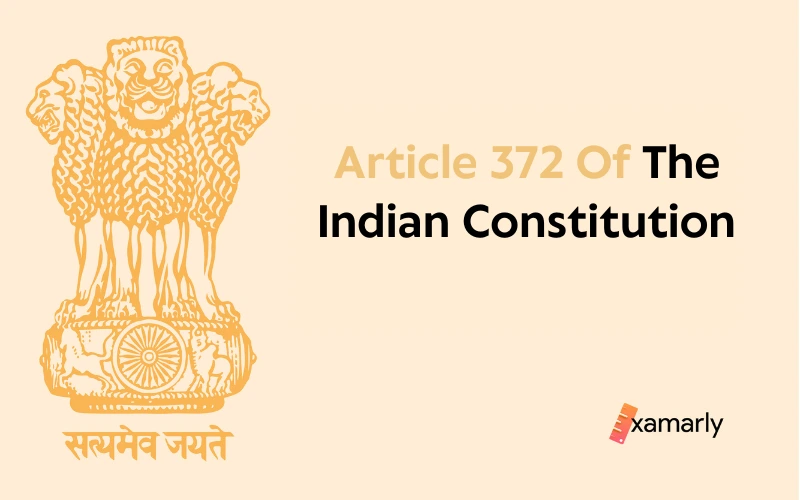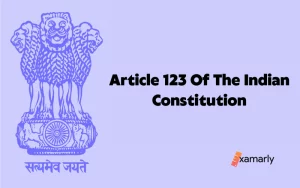Article 372 of the Indian Constitution is an important provision that deals with the continuance of existing laws after the commencement of the Constitution. It sets out the rules for the application and interpretation of existing laws in India and provides the necessary adaptations and modifications to ensure that they are consistent with the provisions of the Constitution.
This article plays a crucial role in establishing the legal framework for the country and ensuring that the transition to the new Constitution is smooth and orderly.
In this article, we will explore the provisions of Article 372 and Article 372A in detail and examine their provision in the context of the Indian legal system.
Provisions Of Article 372 Of The Indian Constitution
The Constitutional provisions of Article 372 are as follows:
- In spite of the fact that this Constitution has repealed the enactments that are mentioned in article 395, but in accordance with the other provisions of this Constitution, every law that was in effect in the territory of India immediately prior to the beginning of this Constitution will continue to be in effect therein until it is changed, repealed, or amended by a competent legislature or some other competent body.
- The President may direct that adaptations and adjustments be made to any law that is already in effect on Indian territory in order to bring its provisions into compliance with those of this Constitution, whether by repeal or amendment. And specify that the legislation will take effect as of the date mentioned in the order, subject to the alterations and changes made and that any such adjustments or modifications will not be challenged in a court of law.
- Nothing in clause (2) shall be interpreted as—
- (a) granting the President the authority to amend or adapt a law after three years have passed since the beginning of this Constitution; or
- (b) preventing any competent Legislature or other competent authority from repealing or modifying a law that the President has so amended or modified.
Explanation I.— The phrase “law in force” in this article refers to a law issued or made by a legislature or other competent authority in the Indian territory before the start of this Constitution and not formerly repealed, even if it or some of its provisions were not then in effect entirely or in some locations.
Explanation II.— Any law that had extraterritorial effect before the inception of this Constitution and that was approved or formed by a Legislature or other competent authority in the Indian territory shall, subject to any such alterations and adaptations as specified, continue to have such extraterritorial effect.
Explanation III.— Nothing in this article may be interpreted as extending the duration of any temporary statute in effect past the date on which it was scheduled to expire or the date on which it would have expired had this Constitution not taken effect.
Explanation IV.— An Ordinance proclaimed by the Governor of a Province under section 88 of the Government of India Act, 1935, and in effect immediately prior to the start of this Constitution shall, unless sooner withdrawn by the Governor of the corresponding State, stop to be in effect at the end of six weeks from the first meeting after the such start of the Legislative Assembly of that State operating under clause (1) of Article 382 of the Indian Constitution. Nothing in this article should be interpreted as keeping any such Ordinance in effect after the specified time period.
All About Article 372A
Article 372A of the Indian Constitution grants the President the authority to adapt laws.
Article 372A: Power Of The President To Adapt Laws
The constitutional provisions of Article 372A are enshrined in the following two clauses:
- The President may, by order issued prior to the first day of November 1957, make such adaptations and changes of the law, whether by way of repeal or amendment, as may be necessary or expedient, in order to bring the provisions of any legislation in effect throughout India or in any part of it, immediately before to the commencement of the Constitution (Seventh Amendment) Act, 1956, into compliance with the provisions of this Constitution as modified by that Act. And stipulate that the legislation shall take effect on the date mentioned in the order, subject to the changes and adaptations made and that any such modification or adaptation shall not be contested in a court of law.
- Nothing in clause (1) should be interpreted as preventing a competent Legislature or other competent body from repealing or altering any law that the President has adapted or changed in accordance with the said clause.
Which Amendment Has Inserted Article 372A?
The 7th amendment of the Indian Constitution inserted Article 372A. The said Article was inserted in Part 21 of the Constitution of India which is entitled “Temporary, Transitional and Special Provision.”
In A Nutshell
Article 372 of the Indian Constitution governs the continuation in force of existing laws as well as any adaptations made to those laws. Article 372A of the Indian Constitution gives the President the ability to make changes to existing laws.
In the Interest of further readings:
| Article 395 Of The Indian Constitution | Article 334 Of The Indian Constitution |
| Article 274 Of The Indian Constitution | Article 350 Of The Indian Constitution |
FAQs On Articles 372 And 372A
What Is Article 395 All About?
Article 395 of the Indian Constitution addresses the repeal of certain acts. The Government of India Act of 1935, the Indian Independence Act of 1947, and all other acts amending or supplementing the latter Act — excluding the Abolition of Privy Council Jurisdiction Act of 1949 — are all thus repealed under Article 395.
What Is The Government of India Act, 1935?
British lawmakers passed the Government of India Act in August 1935. At that point in history, it was the longest act that had ever been passed by the British Parliament. It was split up into two distinct statutes, notably the Government of India Act 1935 and the Government of Burma Act 1935. The central government and the provinces each received a portion of the power that was granted by this Act.
What Is Article 382?
Provisions as to provisional Legislatures for States in Part A of the 1st Schedule of the Indian Constitution are covered under Article 382 of the Constitution of India.
What Article 372 Deals With?
In accordance with Article 372 of the Indian Constitution, existing laws must remain in effect and should be modified.
When Article 372A Was Inserted?
The 7th amendment of the Indian Constitution of 1956 inserted Article 372A to the Indian Constitution in Part XXI.
What Is Clause 1 Of Article 372?
Clause 1 of Article 372 of the Constitution of India states that although certain enactments (laws, ordinances, etc.) have been repealed by the Constitution, all other laws in force in India prior to the commencement of the Constitution will continue to be in force until they are altered, repealed, or amended by a competent Legislature or other competent authority. This means that any laws that were in effect in India before the Constitution came into force will remain in effect unless and until they are changed or repealed by a body with the authority to do so. This provision is subject to the other provisions of the Constitution, which may affect the continuation of these laws in some way.






